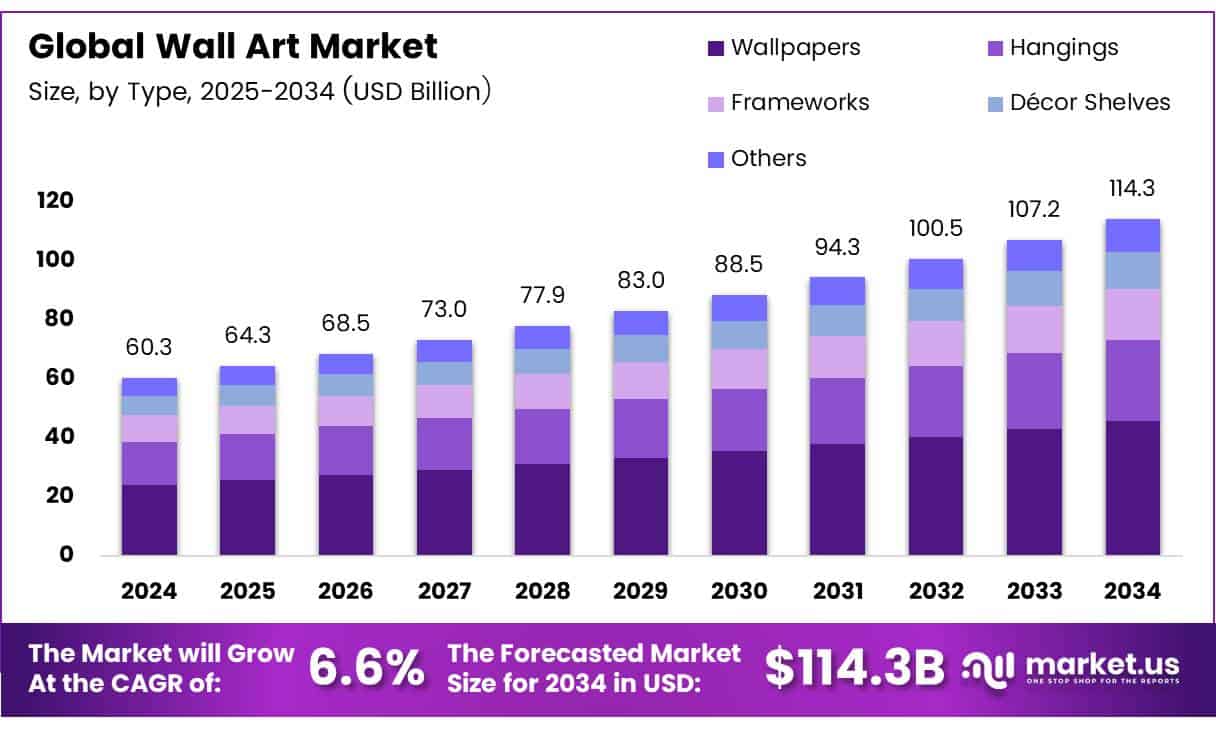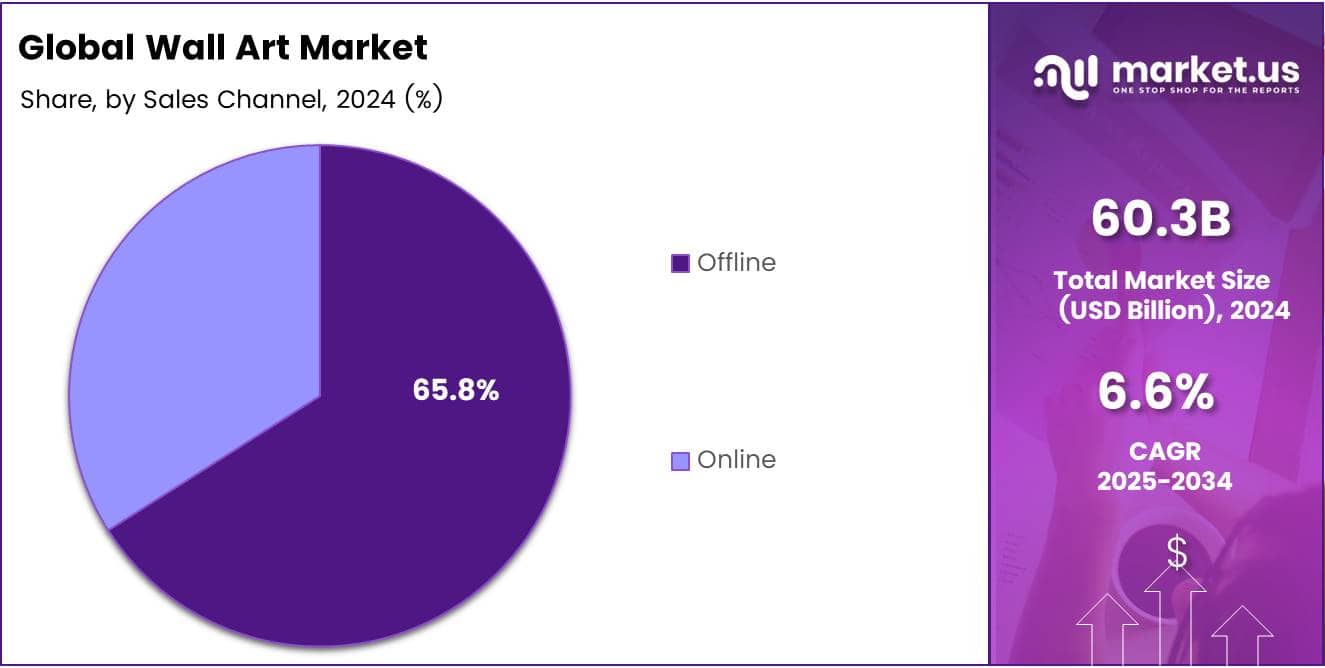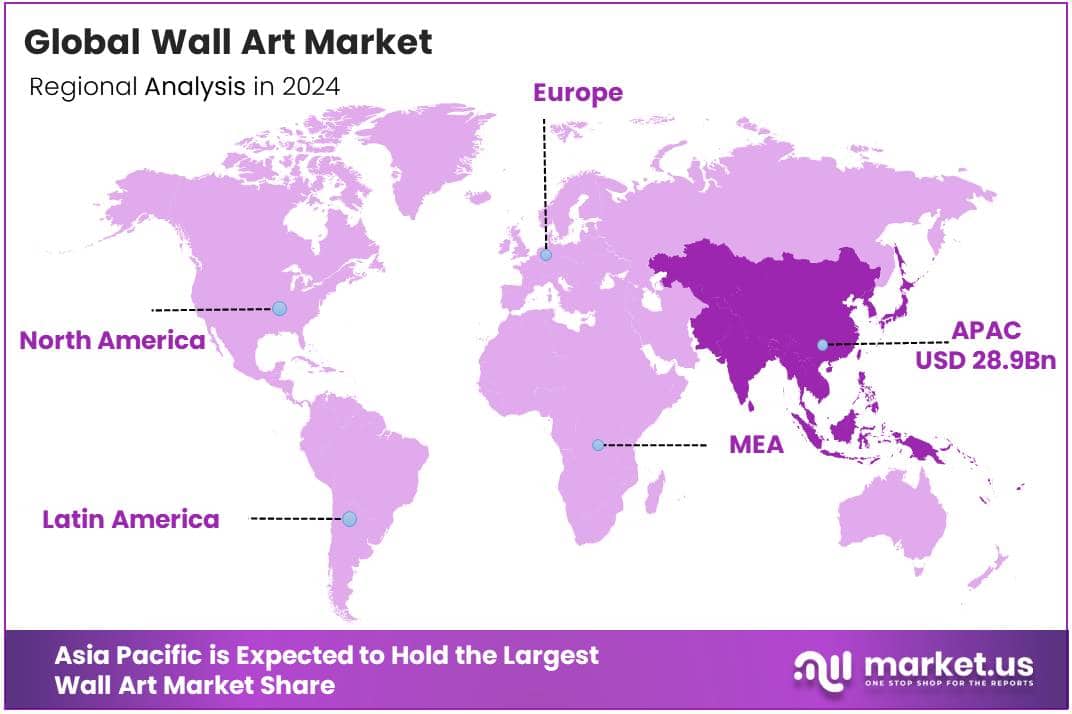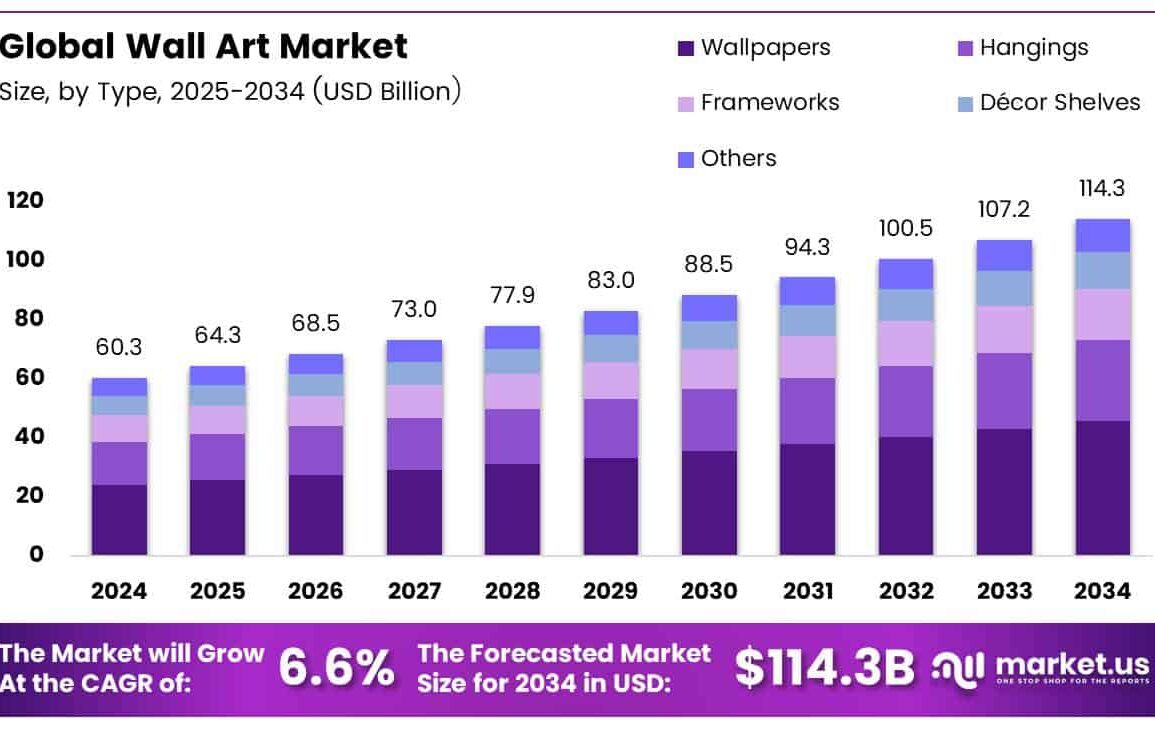Quick Navigation
Report Overview
The Global Wall Art Market size is expected to be worth around USD 114.3 Billion by 2034, from USD 60.3 Billion in 2024, growing at a CAGR of 6.6% during the forecast period from 2025 to 2034.
Wall art encompasses a wide range of decorative pieces, including paintings, photographs, prints, murals, and other visual art forms, used to enhance the aesthetic appeal of residential and commercial spaces. As an essential part of interior design, wall art has evolved beyond traditional fine art into a broader category that includes digital prints, canvas artwork, and custom pieces tailored to personal tastes and home decor styles.


The wall art market has experienced substantial growth due to a combination of factors, including increasing disposable income, the growing trend of home renovation, and rising interest in personalized decor.
Consumers now place a high value on creating spaces that reflect their personal tastes, leading to a growing demand for unique and customized wall art. With the emergence of online platforms, purchasing art has become more accessible, allowing consumers to explore a vast range of products at different price points. This shift has democratized art purchasing, making it easier for people from various backgrounds to access and own artwork.
According to a 2023 survey by Canvas Pop, 51% of American respondents preferred buying art pieces with personal significance for their homes, signaling a strong preference for custom or meaningful art that resonates with personal experiences or styles.
The wall art market shows promising growth prospects, fueled by the increasing integration of art in both residential and commercial spaces. As consumers continue to invest in home decor and remodeling, wall art is viewed as an affordable way to elevate the overall aesthetic of a space.
The demand for wall coverings like wallpaper has also surged, with installation costs ranging between $313 and $819, according to Angi. This indicates a growing market for wall decor products beyond traditional framed art. Additionally, the rise of platforms like Etsy and Society6 has democratized the purchase of wall art, offering opportunities for artists and designers to reach a global audience.
Government investment in the creative industries and art sectors further boosts market growth. Incentives such as tax breaks for art buyers, grants for artists, and cultural funding for exhibitions help cultivate an environment conducive to art sales and creativity.
Additionally, regulations governing art sales, copyrights, and product standards ensure that the market remains structured and transparent, further encouraging consumer confidence.
International trade, including exports of wallpaper and similar coverings from China to Barbados (US$1.82 Thousand in 2023, according to Trading Economics), highlights the global nature of the wall art market and the interconnectedness of regional art economies.
Key Takeaways
- Global Wall Art Market projected to grow from USD 60.3 billion in 2024 to USD 114.3 billion by 2034, at a CAGR of 6.6%.
- Wallpapers lead the Type Analysis segment with a 39.2% market share in 2024, favored for their versatility and ease of application.
- Residential applications dominate the Application Analysis segment, holding a 71.2% market share in 2024, driven by strong demand in home décor.
- Offline sales channels lead with a 65.8% market share in 2024, encompassing Hypermarkets, Supermarkets, Specialty Stores, and other physical outlets.
- Asia Pacific is the largest regional market for wall art, accounting for 48.5% of the global market, valued at USD 28.9 billion in 2024.
Type Analysis
Wallpapers Lead with 39.2% Share in 2024
In 2024, Wallpapers held a dominant market position in the By Type Analysis segment of the Wall Art Market, with a 39.2% share. This segment continues to outpace other forms of wall art due to growing consumer preference for versatile, customizable, and easy-to-apply designs.
Wallpapers and wall coverings, often including peel-and-stick options, have gained traction for their ability to transform spaces with minimal effort, offering a wide array of patterns, textures, and finishes to suit various interior styles.
Following wallpapers, Hangings, which include tapestries and fabric art, secured a substantial market share. This category benefits from the increasing demand for bohemian, rustic, and eclectic interior styles, where hangings serve as both functional and aesthetic pieces. Frameworks, encompassing framed photographs, prints, and artworks, also remain popular, driven by the desire for personalized, timeless decor.
Décor Shelves, often used in combination with other wall art types, are another key component, allowing consumers to display curated collections and decorative items. Lastly, the Others segment includes a range of niche wall art items, such as murals, vinyl decals, and magnetic art, contributing to the overall diversification and customization of the wall art market.
These trends reflect a growing demand for innovative, flexible, and style-conscious wall décor options across residential and commercial spaces.
Application Analysis
Residential Dominates the Wall Art Market with 71.2% Share in 2024, Followed by Commercial Demand Growth
In 2024, Residential held a dominant market position in the By Application Analysis segment of the Wall Art Market, with a 71.2% share. This substantial share reflects the strong consumer demand for home décor, where wall art plays a key role in personalizing living spaces.
The increasing trend toward home renovation, coupled with the rise of e-commerce platforms, has fueled residential interest in a wide variety of wall art styles—from contemporary prints to vintage pieces. The desire for comfort and aesthetic expression in living environments, as well as the growing popularity of DIY home décor, has further contributed to the surge in demand for residential wall art.
On the other hand, the Commercial segment continues to show significant potential for growth. The growing importance of visual branding and workplace ambiance in industries such as hospitality, corporate offices, and retail establishments is driving this demand.
Commercial spaces are increasingly investing in wall art as a means to enhance customer experiences, reinforce brand identities, and create inviting atmospheres. As businesses continue to focus on interior design, the commercial wall art market is expected to witness steady expansion in the coming years.
Sales Channel Analysis
Offline Dominates the Wall Art Market Sales Channel with 65.8% Share in 2024
In 2024, Offline held a dominant market position in the By Sales Channel Analysis segment of the Wall Art Market, with a 65.8% share. This segment includes Hypermarkets and Supermarkets, Specialty Stores, and Other physical retail outlets.
The preference for in-person shopping continues to play a significant role in consumer behavior, especially for high-involvement products like wall art, where tactile experiences and visual inspection are crucial.
Hypermarkets and supermarkets, in particular, contribute a large portion of the offline sales, offering convenience and access to a wide variety of wall art options under one roof.
Specialty stores, known for their curated collections, also attract discerning customers looking for unique and high-quality pieces. The Others category encompasses smaller, independent retailers who serve local and niche markets, further reinforcing the offline dominance in the industry.
On the other hand, the online segment is steadily growing, driven by the increasing adoption of e-commerce and digital platforms for home décor. Despite this growth, online sales of wall art remain lower in comparison to offline sales due to challenges such as shipping logistics and the inability to physically inspect products before purchase.
However, as online platforms continue to enhance customer experiences through augmented reality and improved return policies, this trend is expected to shift in the future.




Key Market Segments
By Type
- Wallpapers/Stickers/Wall Coverings
- Hangings
- Frameworks
- Décor Shelves
- Others
By Application
- Residential
- Commercial
By Sales Channel
- Offline
- Hypermarkets and Supermarkets
- Specialty Stores
- Others
- Online
Drivers
Growing Demand for Wall Art Driven by Home Renovation and Urban Living
The wall art market is experiencing significant growth due to several key drivers. First, the increasing trend of home renovations is contributing to higher demand for decorative pieces.
As more people invest in upgrading their living spaces, they are looking for ways to enhance the look of their walls. Urbanization also plays a crucial role, as more people move to cities with modern apartments where wall art adds style and personality to smaller living spaces.
Additionally, there’s a growing interest in customization, with consumers seeking unique and personalized wall art that reflects their individual tastes. This shift toward custom-made pieces is making art more accessible and appealing to a wider audience. Finally, social media platforms like Instagram and Pinterest have created a visual culture, inspiring people to transform their homes with trendy, stylish wall decor.
The constant sharing of interior design ideas online motivates individuals to incorporate fashionable wall art into their own homes, driving the demand for new and creative designs. These factors combined are not only shaping the demand but also expanding the variety of options available in the wall art market, making it a dynamic and rapidly growing sector.
Restraints
High Cost of Premium Artworks Limits Access for Budget-Conscious Consumers
The wall art market faces several restraints that could impact its growth. One key factor is the high cost of premium artworks, which makes original pieces unaffordable for many consumers.
Many people desire unique and high-quality art for their homes, but the price of original paintings, sculptures, and limited-edition prints can be prohibitively expensive. This limits the market to a smaller, wealthier audience and excludes a large portion of potential buyers who are on a budget.
Additionally, the limited space in urban homes further restricts the demand for larger art pieces. With many city dwellers living in compact apartments or houses with smaller walls, there’s less room to display oversized or bold art pieces. As urbanization continues to rise, especially in densely populated areas, people are increasingly opting for smaller, more minimalist artworks that fit into their living spaces.
These two factors cost and space limitations pose challenges to the growth of the wall art market, as they limit the audience for both high-end and large-scale products. To tap into a broader consumer base, manufacturers and artists may need to offer more affordable options or develop innovative ways to create art that fits well in smaller spaces without sacrificing aesthetic value.
Growth Factors
A Growing Trend for Unique Home and Office Décor
The wall art market is seeing significant growth opportunities, especially with the increasing demand for personalized pieces. Customizing wall art for homes, offices, and commercial spaces allows businesses to cater to individual preferences, creating a unique and high-margin market segment.
Additionally, integrating technology into wall art, such as digital frames or interactive displays, can offer customers a more dynamic and engaging experience, opening doors to innovation in the sector. With technology becoming a key driver of consumer interest, incorporating smart wall décor could position brands to capitalize on future trends.
Furthermore, collaborating with interior designers can unlock valuable partnerships and new sales channels, as designers often influence home and commercial decor choices. This partnership can help wall art brands reach new audiences through referrals and integrated design projects.
Lastly, there is a rising demand for sustainable and eco-friendly products across various industries, including wall art. Offering eco-conscious options such as prints on recycled materials or using non-toxic, environmentally friendly inks can attract a growing base of environmentally aware consumers. With sustainability increasingly on consumers’ minds, brands that prioritize eco-friendly practices will likely gain a competitive edge.
Together, these trends present a rich landscape for growth, with opportunities in personalization, technology, design collaboration, and sustainability driving the future of the wall art market.
Emerging Trends
Framed Canvas Art is Changing the Look of Home Décor
The wall art market is seeing several exciting trends that reflect consumers’ evolving tastes. One prominent trend is framed canvas art, which continues to gain popularity for its sleek and modern aesthetic. The combination of high-quality canvas material with stylish frames adds sophistication to any room, making it a favorite for contemporary home décor.
Another notable trend is mixing different art forms like photography, painting, and digital art. This fusion creates unique, eclectic interiors that allow homeowners to express personal style.
Additionally, cultural and heritage-inspired art is becoming increasingly popular, as more consumers seek pieces that reflect diverse traditions and global influences. This shift highlights a growing appreciation for multiculturalism and history, which is being embraced in both personal and public spaces.
Finally, large-scale wall art is making a bold statement, especially in open-plan living rooms and corporate offices. These oversized pieces are used to create a dramatic focal point and bring energy into larger spaces. As these trends evolve, the wall art market is becoming more versatile and accessible, allowing buyers to find pieces that truly resonate with their individuality and cultural values.
Regional Analysis
Asia Pacific Leads Wall Art Market with 48.5% Share Worth USD 28.9 Billion Driven by Urbanization and Growing Middle Class
The global wall art market is experiencing steady growth across various regions, driven by increasing consumer demand for personalized and aesthetically appealing home decor. Among these regions, Asia Pacific dominates the market, accounting for 48.5% of the total market share, with an estimated value of USD 28.9 billion.
This dominance is primarily attributed to the rapidly growing middle-class population, expanding urbanization, and increasing disposable income in key countries like China, India, and Japan. The rising trend of home renovation and interior design, alongside a growing affinity for wall art among millennials and the expanding e-commerce platforms, further contribute to Asia Pacific’s market supremacy.




Regional Mentions:
North America, particularly the United States, remains a prominent player in the global wall art market. The region benefits from a high standard of living, with a strong cultural affinity for home decoration. Homeownership rates and disposable income continue to drive demand for both traditional and contemporary wall art.
In Europe, the market is experiencing steady growth, with key countries such as the United Kingdom, Germany, and France driving demand. The region is characterized by a rich art heritage and a growing interest in both modern and classic art forms. The market’s expansion is also supported by a focus on high-quality and artisanal products.
Both Middle East & Africa and Latin America represent emerging markets in the global wall art landscape. While these regions contribute a smaller share to the overall market, they are gradually witnessing growth due to increased urbanization, rising incomes, and a growing interest in home decor. However, their market development remains slower in comparison to the leading regions of Asia Pacific, North America, and Europe.
Key Regions and Countries
- North America
- Europe
- Germany
- France
- The UK
- Spain
- Italy
- Rest of Europe
- Asia Pacific
- China
- Japan
- South Korea
- India
- Australia
- Rest of APAC
- Latin America
- Brazil
- Mexico
- Rest of Latin America
- Middle East & Africa
- South Africa
- Saudi Arabia
- UAE
- Rest of MEA
Key Players Analysis
In 2023, the global Wall Art Market is shaped by several key players who leverage diverse business models, digital innovation, and unique product offerings. These companies span a range of business activities, from online marketplaces to bespoke art curation, enabling them to cater to a broad spectrum of consumer preferences.
VGL Group and Minted LLC stand out with their ability to integrate personalization and customization into the wall art space. VGL Group, known for its global reach, is particularly adept at catering to both high-end and mass-market segments. Minted, a pioneer in crowdsourced art, provides unique, customizable prints from independent artists, creating a distinctive value proposition through its design community.
Artsy Inc. and Saatchi Art Limited focus on high-end, curated collections and offer a seamless online experience that connects collectors and artists globally. Artsy has strengthened its market position by expanding into the luxury segment, while Saatchi Art’s broad range of contemporary works appeals to a wide audience, from first-time buyers to seasoned collectors.
On the more accessible side, Art.com Inc. and Society6 LLC cater to mass-market consumers by offering a wide range of affordable and stylish designs. Art.com benefits from its vast catalog and reputation for high-quality reproductions, while Society6 emphasizes artist-driven designs through a platform that champions independent creators.
1stdibs.com Inc., Artspace LLC, and Artnet Worldwide Corporation focus on premium and vintage art, positioning themselves as online luxury marketplaces. These platforms provide a mix of exclusive works and limited-edition prints, appealing to affluent buyers seeking exclusive art investment opportunities.
Top Key Players in the Market
- VGL Group
- Minted LLC
- Artsy Inc
- Art.com Inc.
- Uprise Art LLC
- Saatchi Art Limited
- 1stdibs.com Inc.
- Artspace LLC
- Artnet Worldwide Corporation
- Society6 LLC
Recent Developments
- In September 2024, home décor and lifestyle brand Nestasia secured $8.35 million in funding to accelerate its expansion and strengthen its presence in global markets. The investment will support product innovation and strategic growth across key regions.
- In June 2024, cross-border B2B home décor brand Trampoline raised $5 million in a seed round, with plans to scale its operations internationally and enhance its platform. The funding will be used to refine its tech infrastructure and build relationships with key suppliers and retailers.
- In June 2024, Trampoline secured $5 million in seed funding to revolutionize the global home décor market through a tech-driven platform that connects businesses to innovative suppliers. This capital will help the company improve its logistics and marketing capabilities for future growth.
Report Scope
This post was originally published on this site be sure to check out more of their content






